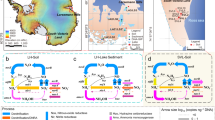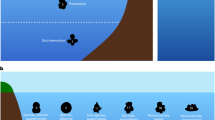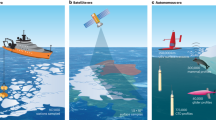Abstract
Human-induced ocean acidification impacts marine life. Marine bacteria are major drivers of biogeochemical nutrient cycles and energy fluxes1; hence, understanding their performance under projected climate change scenarios is crucial for assessing ecosystem functioning. Whereas genetic and physiological responses of phytoplankton to ocean acidification are being disentangled2,3,4, corresponding functional responses of bacterioplankton to pH reduction from elevated CO2 are essentially unknown. Here we show, from metatranscriptome analyses of a phytoplankton bloom mesocosm experiment, that marine bacteria responded to lowered pH by enhancing the expression of genes encoding proton pumps, such as respiration complexes, proteorhodopsin and membrane transporters. Moreover, taxonomic transcript analysis showed that distinct bacterial groups expressed different pH homeostasis genes in response to elevated CO2. These responses were substantial for numerous pH homeostasis genes under low-chlorophyll conditions (chlorophyll a <2.5 μg l−1); however, the changes in gene expression under high-chlorophyll conditions (chlorophyll a >20 μg l−1) were low. Given that proton expulsion through pH homeostasis mechanisms is energetically costly, these findings suggest that bacterioplankton adaptation to ocean acidification could have long-term effects on the economy of ocean ecosystems.
This is a preview of subscription content, access via your institution
Access options
Subscribe to this journal
Receive 12 print issues and online access
$209.00 per year
only $17.42 per issue
Buy this article
- Purchase on Springer Link
- Instant access to full article PDF
Prices may be subject to local taxes which are calculated during checkout



Similar content being viewed by others
References
Azam, F. Microbial control of oceanic carbon flux: the plot thickens. Science 280, 694–696 (1998).
Hennon, G. M. M. et al. Diatom acclimation to elevated CO2 via cAMP signalling and coordinated gene expression. Nature Clim. Change 5, 761–765 (2015).
Lohbeck, K. T., Riebesell, U. & Reusch, T. B. Adaptive evolution of a key phytoplankton species to ocean acidification. Nature Geosci. 5, 346–351 (2012).
Tagliabue, A., Bopp, L. & Gehlen, M. The response of marine carbon and nutrient cycles to ocean acidification: large uncertainties related to phytoplankton physiological assumptions. Glob. Biogeochem. Cycles 25, GB3017 (2011).
Pelejero, C., Calvo, E. & Hoegh-Guldberg, O. Paleo-perspectives on ocean acidification. Trends Ecol. Evol. 25, 332–344 (2010).
Bopp, L. et al. Multiple stressors of ocean ecosystems in the 21st century: projections with CMIP5 models. Biogeosciences 10, 6225–6245 (2013).
Häder, D. P. & Gao, K. Interactions of anthropogenic stress factors on marine phytoplankton. Front. Environ. Sci. 3, 14 (2015)10.3389/fenvs.2015.00014.
Krause, E. et al. Small changes in pH have direct effects on marine bacterial community composition: a microcosm approach. PLoS ONE 7, e47035 (2012).
Grossart, H. P., Allgaier, M., Passow, U. & Riebesell, U. Testing the effect of CO2 concentration on the dynamics of marine heterotrophic bacterioplankton. Limnol. Oceanogr. 51, 1–11 (2006).
Arnosti, C. et al. Dynamics of extracellular enzyme activities in seawater under changed atmospheric p CO 2 : a mesocosm investigation. Aquat. Microb. Ecol. 64, 285–298 (2011).
Allgaier, M. et al. Coupling of heterotrophic bacteria to phytoplankton bloom development at different p CO 2 levels: a mesocosm study. Biogeosciences 5, 1007–1022 (2008).
Lindh, M. V. et al. Consequences of increased temperature and acidification on bacterioplankton community composition during a mesocosm spring bloom in the Baltic Sea. Environ. Microbiol. Rep. 5, 252–262 (2013).
Piontek, J. et al. Acidification increases microbial polysaccharide degradation in the ocean. Biogeosciences 7, 1615–1624 (2010).
Robinson, C. & Williams, P. J. B. in Respiration in Aquatic Ecosystems (eds del Giorgio, P. A. & Williams, P. J. B.) 147–181 (Oxford Univ. Press, 2005).
Field, C. B. et al. (eds) in Impacts, Adaptation, and Vulnerability. Part A: Global and Sectoral Aspects (IPCC, Cambridge Univ. Press, 2014).
Sala, M. M. et al. Contrasting effects of ocean acidification on the microbial food web under different trophic conditions. ICES J. Mar. Sci. (2015)10.1093/icesjms/fsv130.
Baltar, F. et al. Response of rare, common and abundant bacterioplankton to anthropogenic pertubations in a Mediterranean coastal site. FEMS Microbiol. Ecol. 91, fiv058 (2015).
Shibata, C. et al. Gene structure of Enterococcus hirae (Streptococcus faecalis) F1FO-ATPase, which functions as a regulator of cytoplasmic pH. J. Bacteriol. 174, 6117–6124 (1992).
Spero, M. A., Aylward, F. O., Currie, C. R. & Donohue, T. J. Phylogenomic analysis and predicted physiological role of the proton-translocating NADH: quinone oxidoreductase (complex I) across bacteria. mBio 6, e00389–e00415 (2015).
Maurer, L. M. et al. pH regulates genes for flagellar motility, catabolism, and oxidative stress in Escherichia coli K-12. J. Bacteriol. 187, 304–319 (2005).
Mangold, S., Jonna Rao, V. & Dopson, M. Response of Acidithiobacillus caldus toward suboptimal pH conditions. Extremophiles 17, 689–696 (2013).
Gómez-Consarnau, L. et al. Light stimulates growth of proteorhodopsin-containing marine Flavobacteria. Nature 445, 210–213 (2007).
Akram, N. et al. Regulation of proteorhodopsin gene expression by nutrient limitation in the marine bacterium Vibrio sp. AND4. Environ. Microbiol. 15, 1400–1415 (2013).
Fuhrman, J. A., Schwalbach, M. S. & Stingl, U. Proteorhodopsins: an array of physiological roles? Nature Rev. Microbiol. 6, 488–494 (2008).
Duarte, C. M. et al. Is ocean acidification an open-ocean syndrome? Understanding anthropogenic impacts on seawater pH. Estuar. Coast. 36, 221–236 (2013).
Spilling, K. Dense sub-ice bloom of dinoflagellates in the Baltic Sea, potentially limited by high pH. J. Plankton Res. 29, 895–901 (2007).
Buchan, A., LeCleir, G., Gulvik, C. & González, J. Master recyclers: features and functions of bacteria associated with phytoplankton blooms. Nature Rev. Microbiol. 12, 686–698 (2014).
Teeling, H. et al. Substrate-controlled succession of marine bacterioplankton populations induced by a phytoplankton bloom. Science 336, 608–611 (2012).
Del Giorgio, P. A. et al. Coherent patterns in bacterial growth, growth efficiency, and leucine metabolism along a northeastern Pacific inshore-offshore transect. Limnol. Oceanogr. 56, 1–16 (2011).
Riebesell, U. & Gattuso, J. P. Lessons learned from ocean acidification research. Nature Clim. Change 5, 12–14 (2015).
Clayton, T. D. & Byrne, R. H. Spectrophotometric seawater pH measurements: total hydrogen ion concentration scale calibration of m-cresol purple and at-sea results. Deep-Sea Res. I 40, 2115–2129 (1993).
Dickson, A. G., Sabine, C. L. & Christian, J. R. Guide to Best Practices for Ocean CO2 Measurements Vol. 3 (PICES Special Publication, 2007).
Kirchman, D., K’nees, E. & Hodson, R. Leucine incorporation and its potential as a measure of protein synthesis by bacteria in natural aquatic systems. Appl. Environ. Microbiol. 49, 599–607 (1985).
Smith, D. C. & Azam, F. A simple, economical method for measuring bacterial protein synthesis rates in seawater using 3H-leucine. Mar. Microb. Food Webs 6, 107–114 (1992).
Yentsch, C. S. & Menzel, D. W. A method for the determination of phytoplankton chlorophyll and phaeophytin by fluorescence. Deep-Sea Res. I 10, 221–231 (1963).
Allers, E. et al. Response of Alteromonadaceae and Rhodobacteriaceae to glucose and phosphorus manipulation in marine mesocosms. Environ. Microbiol. 9, 2417–2429 (2007).
Pinhassi, J. et al. Changes in bacterioplankton composition under different phytoplankton regimes. Appl. Environ. Microbiol. 70, 6753–6766 (2004).
Poretsky, R. S. et al. Comparative day/night metatranscriptomic analysis of microbial communities in the North Pacific subtropical gyre. Environ. Microbiol. 11, 1358–1375 (2009).
Quast, C. et al. The SILVA ribosomal RNA gene database project: improved data processing and web-based tools. Nucleic Acids Res. 41, D590–D596 (2012).
Del Fabbro, C., Scalabrin, S., Morgante, M. & Giorgi, F. M. An extensive evaluation of read trimming effects on illumina NGS data analysis. PLoS ONE 8, e85024 (2013).
Boisvert, S. et al. Ray Meta: scalable de novo metagenome assembly and profiling. Genome Biol. 13, R122 (2012).
Zerbino, D. R. & Birney, E. Velvet: algorithms for de novo short read assembly using de Bruijn graphs. Genome Res. 18, 821–829 (2008).
Rho, M., Tang, H. & Ye, Y. FragGeneScan: predicting genes in short and error-prone reads. Nucleic Acids Res. 38, e191 (2010).
Edgar, R. C. Search and clustering orders of magnitude faster than BLAST. Bioinformatics 26, 2460–2461 (2010).
Altschul, S. F. et al. Gapped BLAST and PSI-BLAST: a new generation of protein database search programs. Nucleic Acids Res. 25, 3389–3402 (1997).
Overbeek, R. et al. The subsystems approach to genome annotation and its use in the project to annotate 1000 genomes. Nucleic Acids Res. 33, 5691–5702 (2005).
Huson, D. H., Auch, A. F., Qi, J. & Schuster, S. C. MEGAN analysis of metagenomic data. Genome Res. 17, 377–386 (2007).
Tripp, J. H. et al. Misannotations of rRNA can now generate 90% false positive protein matches in metatranscriptomic studies. Nucleic Acids Res. 39, 8792–8802 (2011).
Rivers, A. R. et al. Transcriptional response of bathypelagic marine bacterioplankton to the Deepwater Horizon oil spill. ISME J. 7, 2315–2329 (2013).
Satinsky, B. M. et al. The Amazon continuum dataset: quantitative metagenomic and metatranscriptomic inventories of the Amazon River plume, June 2010. Microbiome 2, 17 (2014).
Beier, S., Rivers, A. R., Moran, M. A. & Obernosterer, I. Phenotypic plasticity in heterotrophic marine microbial communities in continuous cultures. ISME J. 9, 1141–1151 (2015).
Marchetti, A. et al. Comparative metatranscriptomics identifies molecular bases for the physiological responses of phytoplankton to varying iron availability. Proc. Natl Acad. Sci. USA 109, E317–E325 (2011).
Langmead, B. & Salzberg, S. L. Fast gapped-read alignment with Bowtie 2. Nature Methods 9, 357–359 (2012).
Robinson, M. D., McCarthy, D. J. & Smyth, G. K. edgeR: a Bioconductor package for differential expression analysis of digital gene expression data. Bioinformatics 26, 139–140 (2010).
Acknowledgements
The skilful technical assistance of S. Arnautovic, V. Balague, C. Cardelús, L. Cros, E. Vázquez-Domínguez, J. Movilla and À. López-Sanz made this experiment possible. We thank Anselm and the CEAB boat crew for assistance with sampling and M. A. Moran for insightful comments on our work. This research was financially supported by grants from the Göran Gustafsson Foundation for Research in Natural Sciences and Medicine, the Swedish Research Council VR, the Swedish Research Council FORMAS strong research programme EcoChange, and the BONUS BLUEPRINT project, which has received funding from BONUS, the joint Baltic Sea research and development programme (Art 185), funded jointly from the European Union’s Seventh Programme for research, technological development and demonstration and from the Swedish Research Council FORMAS to J.Pinhassi. The research was also financially supported by the Spanish Ministry of Science and Innovation project DOREMI (CTM2012-34294) to C.M. and J.M.Gasol, and by project CTM2013-48292-C3-3-R to J.M.Gasol.
Author information
Authors and Affiliations
Contributions
M.D., C.P., J.M.Gasol and J.Pinhassi conceived the study. C.P., C.M., J.M.Gasol and J.Pinhassi designed research. N.A., M.V.-C., J.M.González, E.C., C.P., C.M., J.M.Gasol and J.Pinhassi carried out the mesocosm experiment and collected samples for microbial and chemical analyses. E.C. and C.M. measured and adjusted pH. N.A., M.V.-C. and J.Palovaara carried out RNA extraction. C.B., D.L., C.M.G.K., L.S., K.H., J.M.González, M.D. and J.Pinhassi analysed data. C.B., D.L. and J.Pinhassi wrote the paper with help from C.M.G.K., L.S. and M.D. All authors discussed the results and commented on the manuscript.
Corresponding author
Ethics declarations
Competing interests
The authors declare no competing financial interests.
Supplementary information
Rights and permissions
About this article
Cite this article
Bunse, C., Lundin, D., Karlsson, C. et al. Response of marine bacterioplankton pH homeostasis gene expression to elevated CO2. Nature Clim Change 6, 483–487 (2016). https://doi.org/10.1038/nclimate2914
Received:
Accepted:
Published:
Issue Date:
DOI: https://doi.org/10.1038/nclimate2914



